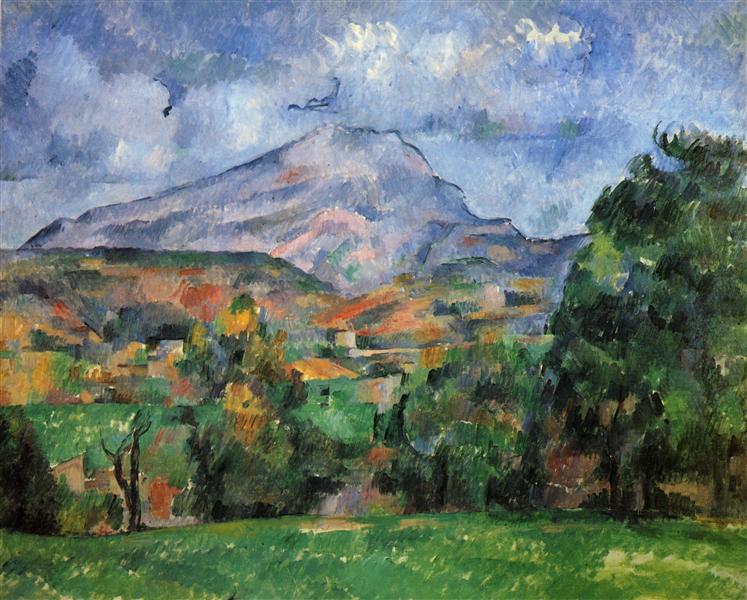Beschreibung
Das Gemälde "Mont Sainte-Victoire" von Paul Cézanne, das 1890 durchgeführt wurde, ist ein repräsentatives Werk des Schritts zur Moderne in der Kunstgeschichte, einem Meilenstein, der die Essenz von Cézannes Suche nach einer neuen visuellen Sprache einfängt. Diese Arbeit, die Teil einer Reihe von Landschaften war, in denen es die Darstellung desselben Berges in der Provence untersuchte, zeigt einen kontinuierlichen Dialog zwischen Form und Farbe und balancierte die Wahrnehmung des Raums und die Struktur der Landschaft.
In dem Gemälde steigt Mont Sainte-Victoire majestätisch auf und besetzt das Zentrum der Komposition. Cézanne baut seine Darstellung auf geometrische Weise auf und verwendet vereinfachte Formen, die die interne Konstruktion der Natur hervorrufen. Der Berg scheint dank der sorgfältigen Disposition der Farben aus der Leinwand zu sprießen, in denen die blauen und violetten Töne auf der Oberseite schmelzen, während die Basis mit einer warmen Orangenpalette und Braun geschmiert ist und das Land hervorruft, das diesen mächtigen Berg stützt . Die Farbbewerbungstechnik unter Verwendung kurzer und energetischer Pinselstriche zeigt die Textur der Landschaft auf eine Weise, die den Betrachter einlädt, seinen Blick von einem Element zum anderen zu verschieben und ein aktives visuelles Erlebnis zu schaffen.
Cézanne ist normalerweise für ihre Herangehensweise an die Komposition bekannt, in der der Raum nicht von der traditionellen naturalistischen Darstellung dominiert wird, sondern wird zu einer fast abstrakten Konstruktion, die ihm eine neue Dimension verleiht. In "Mont Sainte-Victoire" werden Bäume, Vegetation und Straßen so organisiert, dass sie an einem ausgewogenen Tanz um den zentralen Berg teilnehmen, was die Idee der Natur als lebendiger und miteinander verbundener Organismus verstärkt. In der Arbeit sind keine menschlichen Charaktere vorhanden, was das Gefühl der Isolation und Entschlossenheit verstärkt, dass der Berg reflektiert und sowohl die Beständigkeit der Natur als auch die Zerbrechlichkeit der menschlichen Erfahrung in seiner Gegenwart symbolisiert.
Ein faszinierender Aspekt dieses Gemäldes ist Cézannes Fähigkeit, verschiedene Momente des Lichts und der Atmosphäre in einem einzigen Bild zu erfassen. Der Himmel präsentiert eine Reihe von Blues, die subtil in Richtung anderer Farbtöne wandern und einen Horizont erzeugen, der mit dem Licht zu vibrieren scheint. Dieses Interesse an Licht und seine Auswirkung auf die visuelle Wahrnehmung ist einer der Konstanten seiner Arbeit, die es als Vorläufer des Impressionismus stellt, obwohl es ästhetisch von dieser Bewegung zugunsten strukturierterer und energetischerer Arten abweist.
Das Werk zeigt auch den Einfluss der umgebenden Natur auf die künstlerische Entwicklung von Cézanne. Als er in der Region Aix in Provence wohnte, hatte er direkten Zugang zum majestätischen Mont Sainte-Victoire, das während seiner gesamten Karriere zu einem wiederkehrenden Symbol und zu einer Besessenheit wurde. Diese Wiederholung des Themas spricht nicht nur von seiner Liebe zur Landschaft, die ihn umgab, sondern auch von seinem Wunsch, die Prinzipien zu enträtseln, die die Darstellung der visuellen Welt regeln. Der Berg wird somit zu einem kontemplativen Thema, das zeitlich, Form und Farbe reflektiert.
"Mont Sainte-Victoire" von Cézanne ist nicht nur eine Landschaft; Es ist ein Werk, das die Komplexität der Wahrnehmung und die Essenz der modernen Kunst zusammenfasst. Durch sein Gemälde fordert Cézanne den Betrachter auf, mit seiner Vision zu interagieren und die Rolle des Künstlers als Vermittler zwischen Natur und menschlicher Erfahrung zu betrachten. Es ist ein Zeugnis für seine Beherrschung der Suche nach der Wahrheit durch Form und eine tiefe Verbindung mit der Natur, die in seiner Kunst schwingt und die Geschichte der westlichen Kunst unauslöschlich übernommen hat.
KUADROS ©, eine berühmte Farbe an Ihrer Wand.
Handgemachte Ölgemälde, mit der Qualität professioneller Künstler und dem unverwechselbaren Siegel von KUADROS ©.
Pictures Reproduction Service mit Zufriedenheitsgarantie. Wenn Sie mit der Nachbildung Ihres Gemäldes nicht vollständig zufrieden sind, erstatten wir Ihr Geld zu 100%.

